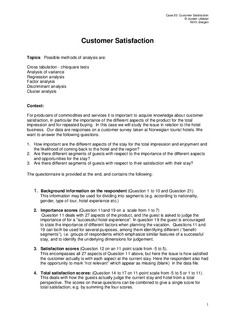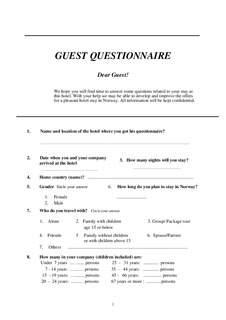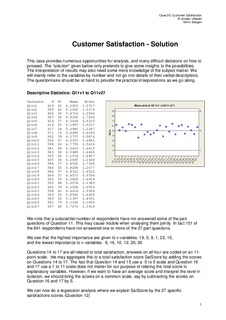| dc.description.abstract | Topics: Possible methods of analysis are:
Cross tabulation - chisquare tests
Analysis of variance
Regression analysis
Factor analysis
Discriminant analysis
Cluster analysis
Context:
For producers of commodities and services it is important to acquire knowledge about customer satisfaction, in particular the importance of the different aspects of the product for the total impression and for repeated buying. In this case we will study the issue in relation to the hotel business. Our data are responses on a customer survey taken at Norwegian tourist hotels. We want to answer the following questions:
1. How important are the different aspects of the stay for the total impression and enjoyment and the likelihood of coming back to the hotel and the region?
2. Are there different segments of guests with respect to the importance of the different aspects and opportunities for the stay?
3. Are there different segments of guests with respect to their satisfaction with their stay?
The questionnaire is provided at the end, and contains the following:
1. Background information on the respondent (Question 1 to 10 and Question 21).
This information may be used for dividing into segments (e.g. according to nationality, gender, type of tour, hotel experience etc.)
2. Importance scores (Question 11and 19 on a scale from 1 to 7)
Question 11 deals with 27 aspects of the product, and the guest is asked to judge the importance of for a ”successful hotel experience”. In question 19 the guest is encouraged to state the importance of different factors when planning the vacation. Questions 11 and 19 can both be used for several purposes, among them identifying different (”benefit-segments”), i.e. groups of respondents which emphasize similar features of a successful stay, and to identify the underlying dimensions for judgement.
3. Satisfaction scores (Question 12 on an 11 point scale from -5 to 5).
This encompasses all 27 aspects of Question 11 above, but here the issue is how satisfied the customer actually is with each aspect at the current stay. Here the respondent also had the opportunity to mark “not relevant” which appear as missing (blank) in the data file.
4. Total satisfaction scores: (Question 14 to 17 on 11-point scale from -5 to 5 or 1 to 11).
This deals with how the guests actually judge the current stay and hotel from a total perspective. The scores on these questions can be combined to give a single score for total satisfaction, e.g. by summing the four scores.
Task
A-version:
Perform a customer satisfaction study that throws light on the questions asked above, i.e.:
1. How important are the different aspects of the stay for the total impression and the likelihood of coming back to the hotel and the region?
2. Are there different segments of guests with respect to the importance of the different aspects and opportunities for the stay?
3. Are there different segments of guests with respect to their satisfaction with their stay?
In doing this it is of importance to be able to judge
i. The statistical issues (assumptions underlying the chosen methods, the handling missing observations etc.)
ii. The practical implications of the findings for improvement opportunities.
B-version
1. Analyse the importance of different aspects for the total satisfaction of the respondent.
At least three different approaches are available and may be compared:
a. Compute the averages of the importance scores of the respondents (question 11)
b. Perform a multiple regression analysis, using the total satisfaction as the dependent variable (question 14-17) and the satisfaction scores for each aspect (question 12) as the explanatory variables. The regression coefficients will then give the relative importance each aspect has for the total satisfaction.
c. Perform a multiple regression analysis, using the total satisfaction as the dependent variable (question 14-17) and different indices scores as the explanatory variables (see pt 3 below). The regression coefficients will then give the relative importance each of the indices (dimensions) have for the total satisfaction of the respondent.
2. Compare the importance of the different aspects for the total satisfaction within different respondent segments.
This may be done by
a. First identify different respondent segments, which can be done in different ways
i. By separating the respondents in groups according to response on specific questions (e.g. gender, frequent traveller or not, lone traveller or not )
ii. By separating the respondents in groups according to factor scores obtained by a factor analysis of the importance variables (Question 11)
iii. By doing a cluster analysis on the importance scores from Question 11, and identify different segments, say 3 to 5.
b. Then perform separate analyses for each segment as under pt. 1 above, and compare the explanatory power (R2) and the regression coefficients.
3. Identification of underlying dimensions of judgement and construction of indices.
It is convenient to uncover some underlying “satisfaction dimensions” that can be brought into the analysis above. To reduce the amount of data we may
a. either use some “product element model” from the literature, group the variables wrt. this directly and compute an index (average or total sum) for each respondent for each element,
b. or we can go via a factor analysis of Question 12 (or 11), and for each respondent compute average or sum satisfaction scores based on Question 12 for each factor identified by the factor analysis
4. Compare the satisfaction scores for different segments.
For the identified segments under pt. 2, we can by an Analysis of variance (ANOVA), determine whether some vacation products ”hit” some segments better than others. In other words is it more difficult to satisfy some segments than others? The analyses may be done alternatively for the
a. Total satisfaction scores (Questions 14 to 17).
b. Satisfaction scores for each aspect (Question 12).
c. Indices based on the answers to Question 12 (see pt. 3 above) | nb_NO |



